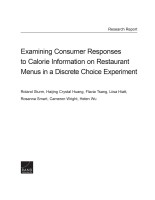| 来源类型 | Research Reports
|
| 规范类型 | 报告
|
| DOI | https://doi.org/10.7249/RR1957
|
| 来源ID | RR-1957-ASPEC
|
| Examining Consumer Responses to Calorie Information on Restaurant Menus in a Discrete Choice Experiment |
| Roland Sturm; Haijing Crystal Huang; Flavia Tsang; Liisa Hiatt; Rosanna Smart; Cameron Wright; Helen Wu
|
| 发表日期 | 2018
|
| 出版年 | 2018
|
| 页码 | 111
|
| 语种 | 英语
|
| 结论 |
Objective 1: Consumer Choice Experiment- Our analysis of participants and their choices suggests that, among participants who selected at least one item, displaying calories on menus reduced the energy amount ordered by 30 kilocalories. Providing calorie information did not affect participants' satisfaction with choices they made or their ratings of restaurants.
- Providing calorie information typically had a statistically significant effect in standard meal–type restaurant settings. In contrast, there was no effect of labeling menus with calorie information on the number of calories participants chose in the three nonstandard meal–type establishments.
- Participants shown menus with calorie-labeled items and those shown menus without labeling were similarly likely to pick the highest-calorie items. However, participants shown the calorie information were less likely to choose items in the 800–1,000 kilocalorie range and more likely to choose items in the 400–500 kilocalorie range than those who were not shown that information.
- In this study, we saw a very strong direct association of sociodemographic characteristics with calories ordered. However, there was no interaction effect of seeing calorie-labeled menus with observable characteristics, including gender, age, education, income, race/ethnicity, or body mass index, on calories chosen. In other words, we found no evidence that the effect of providing calorie information varies by sociodemographic characteristics across all menus.
Objective 2: Evaluation of Menu Changes over Time- We found no statistically significant evidence of a change in calories per menu item between 2010 and 2015 for the menus of major chain restaurants.
|
| 摘要 |
- If we take into account the combination of a main item and its side dishes (rather than only considering the main item), calories in restaurant offerings seem to have increased, rather than decreased, in recent years. The prevalence of customizable menu items is growing rapidly. Establishing an appropriate and standardized method to determine calorie amounts for customizable dishes will be important if researchers and policymakers want to analyze calorie content in restaurant food in the future.
- It is important to note that greater degrees of customization could undermine the informative effects of menu labeling regulations. One of the goals of such labeling is to provide clear and concise information for consumers to use in making food decisions. Menus heavy on customizable dishes will be more difficult for the consumer to navigate, in terms of determining calorie content, because they will have to find and add together multiple calorie labels to calculate the final calorie total for an individual choice. This is a heavy cognitive burden for consumers to face at the point of sale. Consumer education may be necessary to raise awareness of the new trend in customized restaurant items and enable consumers to properly use the nutrition information in restaurants.
|
| 主题 | Diet and Eating Habits
; Nutrition Education
; Nutrition Policy
; Obesity
; Weight Loss
|
| URL | https://www.rand.org/pubs/research_reports/RR1957.html
|
| 来源智库 | RAND Corporation (United States)
|
| 引用统计 |
|
| 资源类型 | 智库出版物
|
| 条目标识符 | http://119.78.100.153/handle/2XGU8XDN/108882
|
推荐引用方式
GB/T 7714 |
Roland Sturm,Haijing Crystal Huang,Flavia Tsang,et al. Examining Consumer Responses to Calorie Information on Restaurant Menus in a Discrete Choice Experiment. 2018.
|
|
文件名:
|
x1540239799799.jpg
|
|
格式:
|
JPEG
|

|
文件名:
|
RAND_RR1957.pdf
|
|
格式:
|
Adobe PDF
|
除非特别说明,本系统中所有内容都受版权保护,并保留所有权利。